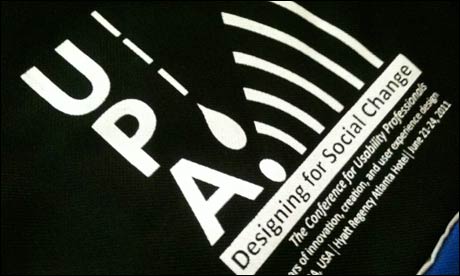I’ve recently come back from Atlanta where I attended the Usability Professionals’ Association conference for the first time.
Facebook’s Paul Adams opened the conference with a talk that was liberally dosed with the company’s “Social by design” mantra. He spent some time examining the social ties that bind us, and what that meant for online applications. “Social” was no longer a bolt-on, he argued, but needed to be at the heart of digital products. “If you don’t reorient your business around people”, he said, “somebody else will.”
There was a strong contingent from the UK talking at the event. Dan Sorvik and Elsa Plumley from Foolproof presented some innovative approaches to using Facebook to carry out research and recruit usability test participants. CX Partners’ Giles Colborne gave a talk on building a framework to train people to carry out field work research, and James Chudley talked about using photographs to improve user experience. Chris How from Brighton’s CogApp presented “Getting effective answers from research sessions”.
The sessions that I found the most value included Carol Barnum & Laura Palmer presenting an overview of how to use Microsoft’s Product Reaction card set, and a great case study by Amy Buckner & Pamela Walshe into how Wells Fargo had carried out a research study into how people used mobile banking applications. As part of this piece of research, users had taken pictures with their phones to report where they had used the app. The team were surprised to discover that often people used the convenience of the mobile device, even when they were sitting at a desk which had a computer on it where they could have accessed the more fully featured desktop banking website.
One of the more fun aspects of the event was that it was the first time the UPA had included “unconference” and Ignite sessions within the programme. These rapid-fire talks injected pace into the proceedings and I enjoyed Rolf Molich’s take on using humour within UX, Kathi Kaiser pondering whether UX resembles a cult, and Christina York’s tips for being a good UX manager.
Then there was Mike Beasley’s presentation on what UX people can learn from cats – to be curious, find a way to make yourself comfortable, don’t burn out, and “be twisty”. And also to use lot of cute pictures of cats in presentations to keep the audience laughing.
There was a panel session featuring some well established practitioners asking whether user testing tools were dangerous “in the wrong hands”. Steve Krug was among those arguing that increasing numbers of people doing amateur testing was, on the whole, a good thing. As his T-shirt put it: “Billions of website. Thousands of usability professionals. You do the math.”
The session was a good debate, with plenty of participation from the audience, and I have to say it closely resembled the debate you hear about “citizen journalism”. In fact, someone even came out with the typical argument “there’s a janitor out there who wants to be your dentist”, and people asked if it is OK for software developers to run usability testing sessions, would it be OK for usability professionals to write code?
Personally I think context is crucial here, and that a lot of basic usability flaws can be picked up by people without training but with good experience of developing web products. There doesn’t, to me, seem to be any great reason to deter them.
That panel was immediately, and appropriately, before my own session. I was in Atlanta to give a presentation entitled “Changing the Guardian through guerrilla usability testing”. It explains how we have supplemented the excellent work of our in-house Research & Customer Insight team with some more lo-fidelity types of testing. There are three case studies in the talk – redesigning Guardian Jobs, the development of our iPhone app, and the ongoing work to relaunch our Culture output online. You can see the presentation on SlideShare, or read an essay version of it.
Dr Bertice Berry spoke on the last day of the event, and described usability professionals as “the social workers of technology”. She compared our profession to a calling, because we don’t see things in the way that most people do, and that we are always putting ourselves into the place of “the other”. She was an energetic and uplifting close to the conference – and her occasional burst into beautiful a capella song was an unexpected presentation technique.
Not one, I hasten to add, that I think I’ll be trying myself.
